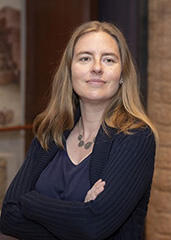 Christina Warinner, Associate Professor of Anthropology, empowers students to explore real-world, thorny topics in science that also have widespread social implications through course work and guest speakers. She brings her own experience as an interdisciplinary researcher to the classroom and directly supports students as they delve into more complex material and learn how to navigate the hidden curriculum (norms of the discipline). Her students practice grappling with interdisciplinary dilemmas in realistic ways. “I want each assignment a student does to be both knowledge-building and skill-building,” she explains. Her courses attract students from both the humanities and sciences, creating a more intellectually diverse learning environment.
Christina Warinner, Associate Professor of Anthropology, empowers students to explore real-world, thorny topics in science that also have widespread social implications through course work and guest speakers. She brings her own experience as an interdisciplinary researcher to the classroom and directly supports students as they delve into more complex material and learn how to navigate the hidden curriculum (norms of the discipline). Her students practice grappling with interdisciplinary dilemmas in realistic ways. “I want each assignment a student does to be both knowledge-building and skill-building,” she explains. Her courses attract students from both the humanities and sciences, creating a more intellectually diverse learning environment.
Learner-centered Pedagogy for Skill-building
The benefits
Students work on interdisciplinary problems that allow them to gain more holistic understandings of vaccinations, pandemic responses, and more—all while becoming more confident in themselves as learners. Students are so engaged with the material and the guest speakers that it becomes hard to stop the discussion when the class reaches its end. “I have students who take my courses who never thought of themselves as a science person,” Warinner says, “but then they start to understand and have a new appreciation for why it’s exciting, and they start to like it. That’s something that I really enjoy."
“I want each assignment a student does to be both knowledge-building and skill-building.”
The challenges
Warinner notes that she often has students with a wide range of subject matter strengths in her course. Some students are more comfortable with writing or presentations, and so on. To account for this, she incorporates not only a range of different assignment types, but also smaller assignments preceding each (for instance smaller writing assignments in addition to the major one) to help students gain confidence in areas that might be outside of their comfort zone.
Takeaways and best practices
-
Rethink the ten-page research paper.
Since long-form research papers are uncommon outside specific academic environments, Warinner replaced the ten-page research paper—which is typically only found in colleges and academia—with practical assignments like writing a review of an article that meets a journal’s requirements, developing a policy plan that follows agency’s guidelines, or designing a budget to study a complex problem. The students learn to seek out opportunities and complete real world research projects. -
Encourage better reading.
Rather than simply providing a list of readings, Warinner asks students to craft an annotated bibliography over the course of the class. Students compose a paragraph-long summary of each required text and can review optional readings for extra credit. As a result, Warinner notes that class discussions are much livelier and deeper, since everyone has clearly done the readings, and students learn important research skills like how to succinctly synthesize texts in their own words. -
Reimagine guest lectures.
Particularly during the pandemic, Warinner found that hosting guest lecturers on a Zoom screen was sometimes draining for students and speakers alike. As an alternative, and to help students sharpen their critical engagement skills, she assigned all students to research the speaker and read two of their articles in advance of class. During class time, instead of a guest lecture, students were split into groups to lead an interview and open Q&A with the speaker. This approach led to a much richer and more dynamic discussion between all parties involved and led to deeper and more insightful reflections on the scientific process and professionalization.
Bottom line
Warinner integrated small changes to her courses to reflect real-world skills and knowledge production and she will likely continue to make tweaks each semester. She underscores how rewarding even the slightest change can be. On top of providing more variety for the instructor, faculty get to see “a whole other side to students” as they bring their own creativity into classroom learning.
